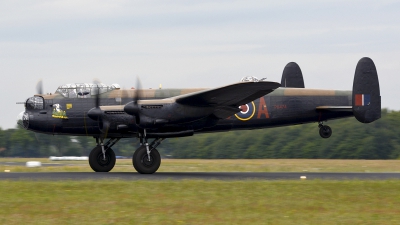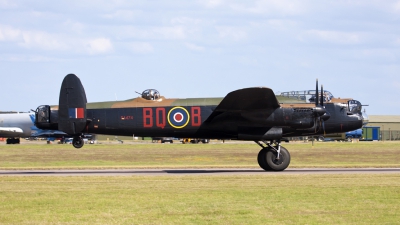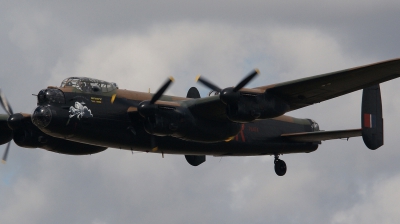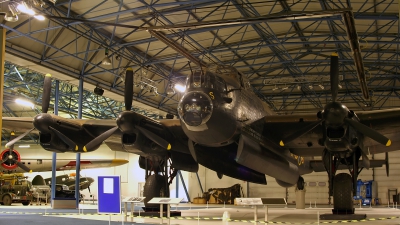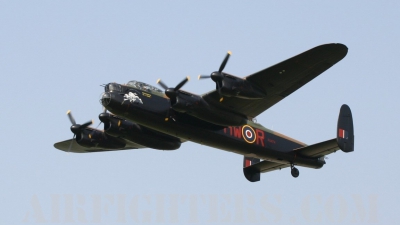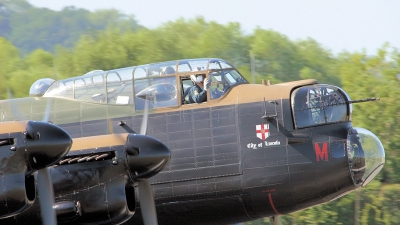Avro 683 Lancaster B.I Aircraft Data
Not long after the issue of B.1/39, for a bomber landplane, the Air Ministry expressed interest in the A.V.Roe & Co. Ltd. proposals for a four engined aircraft, a derivative of the Manchester bomber. This new aircraft, Type 683, had its wing span enlarged to 90 feet, featured an enlarged tailplane and four Merlin X engines. With the planned introduction by Rolls Royce of the Merlin XX, increasing the power to over 1,200 hp at 20,000ft, A.V. Roe was quick to recognise the value of the XX. In February 1940, a new set of calculations for the Type 683 referred to a top speed of slightly over 300 mph at 18,000ft, with an estimated maximum all-up weight of 58,000lbs.
On the 9 January 1941, BT308, the first "Lancaster"-prototype took to the air. Although as early of February 1940, the Type 683 was referred to by A.V.Roe's design department as the "Lancaster", for security reasons the firm had been instructed by the Air Ministry to stop using this name and therefore BT308's first flight was as a "Manchester Mk.III".
Trials at the A&AEE at Boscombe Down followed in February and March by which time the Air Ministry had formally approved the name "Lancaster".
Back with the manufacturer, BT308, had four new Merlin XXs installed. The central fin was removed and two enlarged fins and rudders fitted.
The first production Lancaster, L7527, made her maiden flight on 31 October, 1941, from Woodford.
On Christmas Eve 1941, the first three Lancasters (L7530, L7537 and L7538) arrived at RAF Waddington for No. 44 (Rhodesia) Squadron, RAF. Soon, No.97 (Straits Settlements) Squadron at RAF Coningsby would follow.
Lancaster B.I production:
A.V. Roe & Co. Ltd., Newton Heath, Manchester: Three prototypes, the first being BT308, a Manchester airframe modified for the installation of four Merlin X engines and retaining the central fin. The other two prototypes were DG595 and DT810. A fourth envisaged prototype, DT812, was not built.
A.V. Roe & CO. Ltd., Chadderton, Manchester, with final assembly at Woodford: 43 aircraft (originally ordered as Manchester I, but completed as the first production batch of Lancaster Mk.I).
Metropolitan-Vickers Ltd., Trafford Park, Manchester:
56 aircraft (originally ordered as Manchester I, but completed as Lancaster Mk.I).
200 aircraft (second production batch).
207 aircraft (third production batch).
129 aircraft (fourth production batch).
One aircraft (ninth production batch of in total 723 aircraft of which 722 were built as Lancaster III).
225 aircraft (tenth production batch).
32 aircraft Lancaster I (Special). These Lancasters were adapted to carry the 22,000lb Grand Slam weapon and were delivered between January and March 1945.
A.V.Roe & Co. Ltd., Yeadon: 10 aircraft (fifth production batch of in total 350 aircraft; all other finished as Lancaster III).
44 aircraft (sixth production batch of in total 200 aircraft; 156 aircraft finished as Lancaster III).
Metropolitan-Vickers Ltd., Trafford Park, Manchester: 57 aircraft (first production batch, ordered as Manchesters but completed as Lancaster I)
170 (second production batch).
91 aircraft (third production batch).
250 aircraft (fourth production batch, of which 7 aircraft were converted to Lancaster III).
Metropolitan-Vickers Ltd., Mosley Road, Manchester: 200 aircraft (fifth production batch).
121aircraft (sixth production batch).
Vickers-Armstrong Ltd., Castle Bromwich, Birmingham: 200 aircraft (initially ordered as Lancaster II, then changed to Lancaster III, but ultimately built as Lancaster I).
Vickers-Armstrong Ltd., Chester: 235 aircraft (first production batch).
100 aircraft (second production batch).
15 aircraft (aircraft built by Metropolitan-Vickers Ltd., but assembled by Vickers-Armstrong at Chester).
Sir W.G. Armstrong-Whitworth Aircraft Ltd., Whitley, Coventry: 350 aircraft (third production batch).
400 aircraft (fourth production batch).
65 aircraft (fifth production batch of 170 aircraft, the remainder built as Lancaster III).
25 aircraft as Lancaster I (FE), built in June and July 1945 for service in the Far East for the Tiger Force.
21 aircraft (batch built during June 1945)
50 aircraft (produced between July 1945 and March 1946).
Austin Motors Ltd., Longbridge, Birmingham:
100 aircraft (first production batch).
50 aircraft (second production batch).
Total B.I production, including 3 prototypes, 32 B.I (Specials) and 25 B.I (FE): 3428 aircraft.
Engines for the Lancaster I:
Four Rolls Royce Merlin XX, 1,390 hp (1,036 kW)
Four Rolls Royce Merlin 22, 1,490 hp (1,111 kW)
Four Rolls Royce Merlin 24, 1,610 hp (1,200 kW)
Today only a handful of Lancasters survive, with two airworthy examples: B.I PA474 with the Battle of Britain Memorial Flight at RAF Coningsby in Lincolnshire, England, and B.X FM213 with the Canadian Warplane Heritage at Hamilton, Ontario, Canada. Meanwhile efforts are made at the Lincolnshire Aviation Heritage Centre at East Kirkby to return their Lancaster B.VII NX611 to the skies.
The oldest surviving Lancaster B.I is preserved in the RAF Museum at Hendon. R5868 served with 83 Squadron at RAF Scampton and RAF Wyton before transferring to 467 Squadron, RAAF at RAF Bottesford. Coded 'PO-S', R5868 completed 137 operational sorties.
Lancaster B.I W4783 is on display at the Australian War Memorial at Canberra. The machine flew 90 operational sorties with 460 Squadron, RAAF.
On the 9 January 1941, BT308, the first "Lancaster"-prototype took to the air. Although as early of February 1940, the Type 683 was referred to by A.V.Roe's design department as the "Lancaster", for security reasons the firm had been instructed by the Air Ministry to stop using this name and therefore BT308's first flight was as a "Manchester Mk.III".
Trials at the A&AEE at Boscombe Down followed in February and March by which time the Air Ministry had formally approved the name "Lancaster".
Back with the manufacturer, BT308, had four new Merlin XXs installed. The central fin was removed and two enlarged fins and rudders fitted.
The first production Lancaster, L7527, made her maiden flight on 31 October, 1941, from Woodford.
On Christmas Eve 1941, the first three Lancasters (L7530, L7537 and L7538) arrived at RAF Waddington for No. 44 (Rhodesia) Squadron, RAF. Soon, No.97 (Straits Settlements) Squadron at RAF Coningsby would follow.
Lancaster B.I production:
A.V. Roe & Co. Ltd., Newton Heath, Manchester: Three prototypes, the first being BT308, a Manchester airframe modified for the installation of four Merlin X engines and retaining the central fin. The other two prototypes were DG595 and DT810. A fourth envisaged prototype, DT812, was not built.
A.V. Roe & CO. Ltd., Chadderton, Manchester, with final assembly at Woodford: 43 aircraft (originally ordered as Manchester I, but completed as the first production batch of Lancaster Mk.I).
Metropolitan-Vickers Ltd., Trafford Park, Manchester:
56 aircraft (originally ordered as Manchester I, but completed as Lancaster Mk.I).
200 aircraft (second production batch).
207 aircraft (third production batch).
129 aircraft (fourth production batch).
One aircraft (ninth production batch of in total 723 aircraft of which 722 were built as Lancaster III).
225 aircraft (tenth production batch).
32 aircraft Lancaster I (Special). These Lancasters were adapted to carry the 22,000lb Grand Slam weapon and were delivered between January and March 1945.
A.V.Roe & Co. Ltd., Yeadon: 10 aircraft (fifth production batch of in total 350 aircraft; all other finished as Lancaster III).
44 aircraft (sixth production batch of in total 200 aircraft; 156 aircraft finished as Lancaster III).
Metropolitan-Vickers Ltd., Trafford Park, Manchester: 57 aircraft (first production batch, ordered as Manchesters but completed as Lancaster I)
170 (second production batch).
91 aircraft (third production batch).
250 aircraft (fourth production batch, of which 7 aircraft were converted to Lancaster III).
Metropolitan-Vickers Ltd., Mosley Road, Manchester: 200 aircraft (fifth production batch).
121aircraft (sixth production batch).
Vickers-Armstrong Ltd., Castle Bromwich, Birmingham: 200 aircraft (initially ordered as Lancaster II, then changed to Lancaster III, but ultimately built as Lancaster I).
Vickers-Armstrong Ltd., Chester: 235 aircraft (first production batch).
100 aircraft (second production batch).
15 aircraft (aircraft built by Metropolitan-Vickers Ltd., but assembled by Vickers-Armstrong at Chester).
Sir W.G. Armstrong-Whitworth Aircraft Ltd., Whitley, Coventry: 350 aircraft (third production batch).
400 aircraft (fourth production batch).
65 aircraft (fifth production batch of 170 aircraft, the remainder built as Lancaster III).
25 aircraft as Lancaster I (FE), built in June and July 1945 for service in the Far East for the Tiger Force.
21 aircraft (batch built during June 1945)
50 aircraft (produced between July 1945 and March 1946).
Austin Motors Ltd., Longbridge, Birmingham:
100 aircraft (first production batch).
50 aircraft (second production batch).
Total B.I production, including 3 prototypes, 32 B.I (Specials) and 25 B.I (FE): 3428 aircraft.
Engines for the Lancaster I:
Four Rolls Royce Merlin XX, 1,390 hp (1,036 kW)
Four Rolls Royce Merlin 22, 1,490 hp (1,111 kW)
Four Rolls Royce Merlin 24, 1,610 hp (1,200 kW)
Today only a handful of Lancasters survive, with two airworthy examples: B.I PA474 with the Battle of Britain Memorial Flight at RAF Coningsby in Lincolnshire, England, and B.X FM213 with the Canadian Warplane Heritage at Hamilton, Ontario, Canada. Meanwhile efforts are made at the Lincolnshire Aviation Heritage Centre at East Kirkby to return their Lancaster B.VII NX611 to the skies.
The oldest surviving Lancaster B.I is preserved in the RAF Museum at Hendon. R5868 served with 83 Squadron at RAF Scampton and RAF Wyton before transferring to 467 Squadron, RAAF at RAF Bottesford. Coded 'PO-S', R5868 completed 137 operational sorties.
Lancaster B.I W4783 is on display at the Australian War Memorial at Canberra. The machine flew 90 operational sorties with 460 Squadron, RAAF.
- Country of Origin: United Kingdom
- First Flight: 9 January 1941
- Initial Service Date: 3 March 1942
- No. Built: 3,428
- No. In Service: 1
- No. of Hardpoints: 0
- Crew: 7
Power:
Rolls Royce Merlin XX at 1,390 hp
Weapons:
Defensive armament:
The standard defensive armament of the Lancaster I was eight 0.303in machine guns, two each in the front and dorsal turret and four in the tail turret. Late production aircraft had two 0.5in machine guns fitted.
The war load of the Lancaster B.I was originally around 7,000lb but increased during service to include 8,000 and 12,000lb bombs. The Lancaster B.I (Special) was adapted to carry the 22,000lb Grand Slam weapon.
The bomb load included mines, incendiary clusters, target indicator bombs.
The standard defensive armament of the Lancaster I was eight 0.303in machine guns, two each in the front and dorsal turret and four in the tail turret. Late production aircraft had two 0.5in machine guns fitted.
The war load of the Lancaster B.I was originally around 7,000lb but increased during service to include 8,000 and 12,000lb bombs. The Lancaster B.I (Special) was adapted to carry the 22,000lb Grand Slam weapon.
The bomb load included mines, incendiary clusters, target indicator bombs.
Dimensions:
| Length: | 69 ft 6 in. |
| Wing Span: | 102 ft 0 in. |
| Wing Area: | 1,297 sq.ft |
| Height: | 20 ft 6 in. |
| Empty Weight: | 37,000 lbs |
| Max. Weight: | 65,000 lbs |
| Max. Ordnance Load: | 22,000 lbs |
| Internal Fuel: | 16,038 lbs |
Performance:
| Max. Speed: | 275 mph |
| Cruise Speed: | 200 mph |
| Service Ceiling: | 19,000 ft. |
| Normal Range: | 1,730 nm |
| Max. Range: | 2,530 nm |
Operators:
The Lancaster I was in service with the air forces of:Argentina
The Argentine Air Force received 15 ex-RAF Lancaster B.Is. The aircraft with Argentine serials B-031 to B-045 were delivered between May 1948 and August 1949.
Australia
Three Royal Australian Air Force units, 460, 463 and 467 Squadrons operated the Lancaster B.I in the European war.
Canada
Five units of the Royal Canadian Air Force operated the B.I: 405, 424, 427, 428 and 433 Squadrons.
Egypt
The air force of Egypt received 9 former RAF Lancaster B.Is, serialled 1801 to 1809. The aircraft were refurbished at Bracebridge Heath, Lincoln and prepared at Langar and subsequently flown south to their new owner.
France
The French naval air arm, the Aeronavale, received 32 aircraft, modified at Langar and Woodford to full ASR standard with serials WU-02, WU-17 and WU-24 to WU-53.
New Zealand
No. 75 (New Zealand) Squadron operated the Lancaster B.I in Northwest Europe.
Sweden
In May 1951 the Swedish Air Force Test Establishment, the Försökscentralen, at Malmen near Linköping received one Lancaster B.I (ex-RAF RA805). The aircraft was modified by Avro company for jet engine testbed duties and designated Tp 80, with Swedish Air Force serial 80001.
On 8 May 1956 during a test flight with an RM6A a Rolls Royce Avon jet engine with afterburner), the Lancaster caught fire in no. 1 engine. Although two of the crew managed to bale out, the two other crew members were killed when the aircraft crashed near Slaka Kyrka near Linköping.
United Kingdom
No less than 45 front line RAF squadrons were equipped with the Lancaster B.1: 7, 9, 12, 15, 35, 44, 49, 50, 57, 61, 70, 83, 90, 97, 100, 101, 103, 106, 115, 138, 148, 149, 150, 153, 156, 166, 170, 186, 189, 195, 207, 214, 218, 300, 514, 550, 576, 582, 617, 619, 622, 625, 626, 630 and 635.
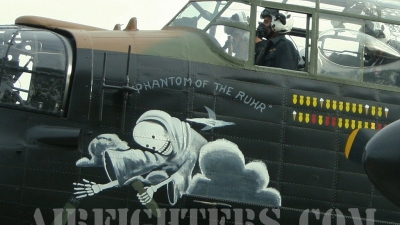
 Random great photos of the Avro 683 Lancaster B.I:
Random great photos of the Avro 683 Lancaster B.I:
